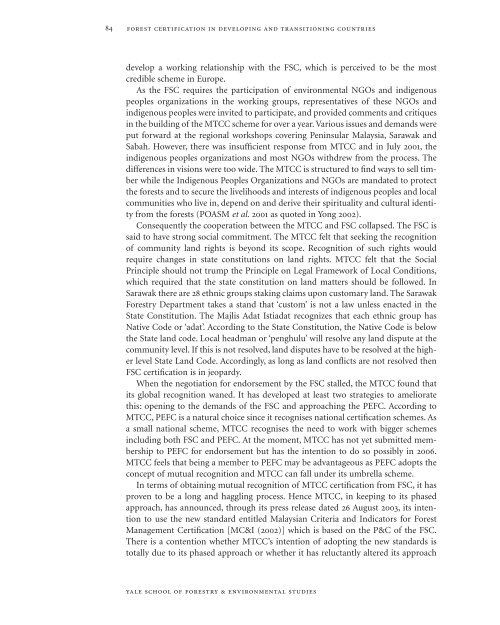Forest Certification in Malaysia - Yale University
Forest Certification in Malaysia - Yale University
Forest Certification in Malaysia - Yale University
You also want an ePaper? Increase the reach of your titles
YUMPU automatically turns print PDFs into web optimized ePapers that Google loves.
84<br />
forest certification <strong>in</strong> develop<strong>in</strong>g and transition<strong>in</strong>g countries<br />
develop a work<strong>in</strong>g relationship with the FSC, which is perceived to be the most<br />
credible scheme <strong>in</strong> Europe.<br />
As the FSC requires the participation of environmental NGOs and <strong>in</strong>digenous<br />
peoples organizations <strong>in</strong> the work<strong>in</strong>g groups, representatives of these NGOs and<br />
<strong>in</strong>digenous peoples were <strong>in</strong>vited to participate, and provided comments and critiques<br />
<strong>in</strong> the build<strong>in</strong>g of the MTCC scheme for over a year. Various issues and demands were<br />
put forward at the regional workshops cover<strong>in</strong>g Pen<strong>in</strong>sular <strong>Malaysia</strong>, Sarawak and<br />
Sabah. However, there was <strong>in</strong>sufficient response from MTCC and <strong>in</strong> July 2001, the<br />
<strong>in</strong>digenous peoples organizations and most NGOs withdrew from the process. The<br />
differences <strong>in</strong> visions were too wide. The MTCC is structured to f<strong>in</strong>d ways to sell timber<br />
while the Indigenous Peoples Organizations and NGOs are mandated to protect<br />
the forests and to secure the livelihoods and <strong>in</strong>terests of <strong>in</strong>digenous peoples and local<br />
communities who live <strong>in</strong>, depend on and derive their spirituality and cultural identity<br />
from the forests (POASM et al. 2001 as quoted <strong>in</strong> Yong 2002).<br />
Consequently the cooperation between the MTCC and FSC collapsed. The FSC is<br />
said to have strong social commitment. The MTCC felt that seek<strong>in</strong>g the recognition<br />
of community land rights is beyond its scope. Recognition of such rights would<br />
require changes <strong>in</strong> state constitutions on land rights. MTCC felt that the Social<br />
Pr<strong>in</strong>ciple should not trump the Pr<strong>in</strong>ciple on Legal Framework of Local Conditions,<br />
which required that the state constitution on land matters should be followed. In<br />
Sarawak there are 28 ethnic groups stak<strong>in</strong>g claims upon customary land. The Sarawak<br />
<strong>Forest</strong>ry Department takes a stand that ‘custom’ is not a law unless enacted <strong>in</strong> the<br />
State Constitution. The Majlis Adat Istiadat recognizes that each ethnic group has<br />
Native Code or ‘adat’. Accord<strong>in</strong>g to the State Constitution, the Native Code is below<br />
the State land code. Local headman or ‘penghulu’ will resolve any land dispute at the<br />
community level. If this is not resolved, land disputes have to be resolved at the higher<br />
level State Land Code. Accord<strong>in</strong>gly, as long as land conflicts are not resolved then<br />
FSC certification is <strong>in</strong> jeopardy.<br />
When the negotiation for endorsement by the FSC stalled, the MTCC found that<br />
its global recognition waned. It has developed at least two strategies to ameliorate<br />
this: open<strong>in</strong>g to the demands of the FSC and approach<strong>in</strong>g the PEFC. Accord<strong>in</strong>g to<br />
MTCC, PEFC is a natural choice s<strong>in</strong>ce it recognises national certification schemes. As<br />
a small national scheme, MTCC recognises the need to work with bigger schemes<br />
<strong>in</strong>clud<strong>in</strong>g both FSC and PEFC. At the moment, MTCC has not yet submitted membership<br />
to PEFC for endorsement but has the <strong>in</strong>tention to do so possibly <strong>in</strong> 2006.<br />
MTCC feels that be<strong>in</strong>g a member to PEFC may be advantageous as PEFC adopts the<br />
concept of mutual recognition and MTCC can fall under its umbrella scheme.<br />
In terms of obta<strong>in</strong><strong>in</strong>g mutual recognition of MTCC certification from FSC, it has<br />
proven to be a long and haggl<strong>in</strong>g process. Hence MTCC, <strong>in</strong> keep<strong>in</strong>g to its phased<br />
approach, has announced, through its press release dated 26 August 2003, its <strong>in</strong>tention<br />
to use the new standard entitled <strong>Malaysia</strong>n Criteria and Indicators for <strong>Forest</strong><br />
Management <strong>Certification</strong> [MC&I (2002)] which is based on the P&C of the FSC.<br />
There is a contention whether MTCC’s <strong>in</strong>tention of adopt<strong>in</strong>g the new standards is<br />
totally due to its phased approach or whether it has reluctantly altered its approach<br />
yale school of forestry & environmental studies
















